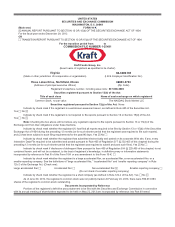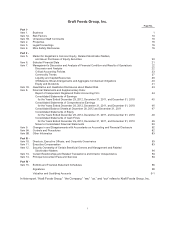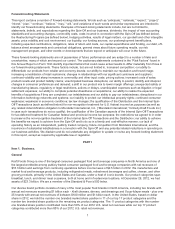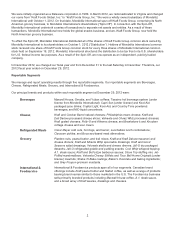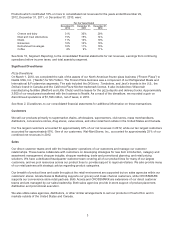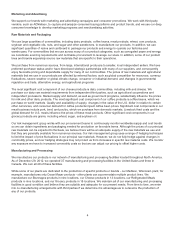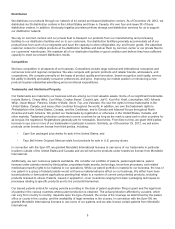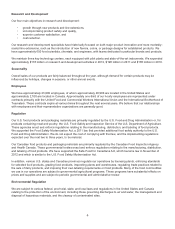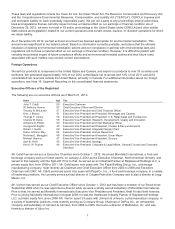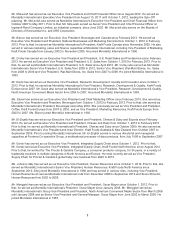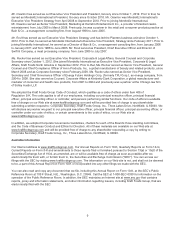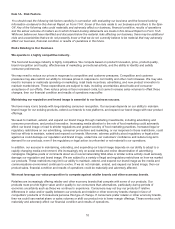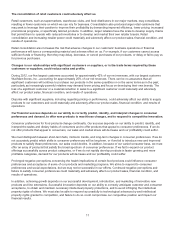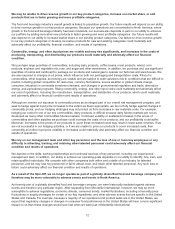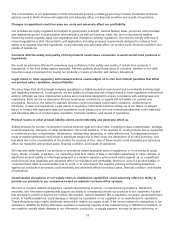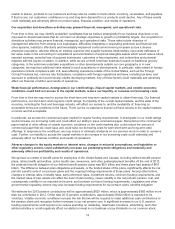Kraft 2012 Annual Report Download - page 6
Download and view the complete annual report
Please find page 6 of the 2012 Kraft annual report below. You can navigate through the pages in the report by either clicking on the pages listed below, or by using the keyword search tool below to find specific information within the annual report.Marketing and Advertising
We support our brands with marketing and advertising campaigns and consumer promotions. We work with third-party
vendors, such as ACNielsen, to capture and analyze consumer buying patterns and product trends, and we use our deep
consumer knowledge to develop marketing programs and merchandising activities.
Raw Materials and Packaging
We use large quantities of commodities, including dairy products, coffee beans, meat products, wheat, corn products,
soybean and vegetable oils, nuts, and sugar and other sweeteners, to manufacture our products. In addition, we use
significant quantities of resins and cardboard to package our products and energy to operate our factories and
warehouses. For commodities that we use across many of our product categories, such as corrugated paper and energy,
we coordinate sourcing requirements and centralize procurement to leverage our scale. In addition, some of our product
lines and brands separately source raw materials that are specific to their operations.
We purchase from numerous sources, from large, international producers to smaller, local independent sellers. We have
preferred purchaser status and/or have developed strategic partnerships with many of our suppliers, and consequently
enjoy favorable pricing and dependable supply for many of our commodities. The prices of raw materials and agricultural
materials that we use in our products are affected by external factors, such as global competition for resources, currency
fluctuations, severe weather or global climate change, consumer or industrial demand, and changes in governmental
regulation and trade, alternative energy, and agricultural programs.
The most significant cost component of our cheese products is dairy commodities, including milk and cheese. We
purchase our dairy raw material requirements from independent third parties, such as agricultural cooperatives and
independent processors. Market supply and demand, as well as government programs, substantially influence the prices
for milk and other dairy products. The most significant cost component of our coffee products is coffee beans, which we
purchase on world markets. Quality and availability of supply, changes in the value of the U.S. dollar in relation to certain
other currencies, and consumer demand for coffee products impact coffee bean prices. Significant cost components in our
meat business include pork, beef, and poultry, which we purchase from domestic markets. Livestock feed costs and the
global demand for U.S. meats influence the prices of these meat products. Other significant cost components in our
grocery products are grains, including wheat, sugar, and soybean oil.
Our risk management group works with our procurement teams to continuously monitor worldwide supply and cost trends
so we can obtain ingredients and packaging needed for production on favorable terms. Although the prices of our principal
raw materials can be expected to fluctuate, we believe there will be an adequate supply of the raw materials we use and
that they are generally available from numerous sources. Our risk management group uses a range of hedging techniques
to limit the impact of price fluctuations in our principal raw materials. However, we do not fully hedge against changes in
commodity prices, and our hedging strategies may not protect us from increases in specific raw material costs. We monitor
any exposure we have to increased commodity costs so that we can adjust our pricing to offset higher costs.
Manufacturing and Processing
We manufacture our products in our network of manufacturing and processing facilities located throughout North America.
As of December 29, 2012, we operated 37 manufacturing and processing facilities in the United States and three in
Canada. We own all 40 of these facilities.
While some of our plants are dedicated to the production of specific products or brands - our Madison, Wisconsin plant, for
example, manufactures only Oscar Mayer products - other plants can accommodate multiple product lines. We
manufacture our Beverages products in nine locations, our Cheese products in 13 locations, our Refrigerated Meals
products in nine locations, and our Grocery products in 15 locations. We maintain all of our manufacturing and processing
facilities in good condition and believe they are suitable and adequate for our present needs. From time to time, we enter
into co-manufacturing arrangements with third parties if we determine it is advantageous to outsource the production of
any of our products.
4

